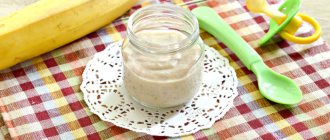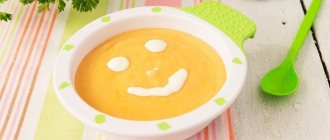Edited by an expert:
Nadezhda Primochkina, nutritionist - 06/12/2020
Fermented milk products must be present in a child’s diet. Daily consumption of yogurt stabilizes the functioning of the intestines - the bacteria it contains improve digestion.
Nutritionists say that yogurt helps children's bodies absorb nutrients from other foods. Today we will reveal all the ins and outs of such a popular children's dessert, and you will find out how real and healthy yogurt differs from an advertising panacea.
How is real yogurt made and what does it consist of?
Real yogurt contains only two components - milk and starter culture , which contains beneficial bacteria. These are mainly thermophilic streptococcus and Bulgarian bacillus. Yogurt may contain other ingredients, such as sugar and milk powder, but in many countries, truly authentic yogurt is one that consists only of milk and culture, without adding anything else. Other options are not accepted. And it is right! Who knows how many not-so-healthy additives manufacturers hide in beautiful jars of their favorite children's product.
For example, stabilizers help achieve a creamy consistency, flavorings saturate the yogurt with flavor and give it the necessary aroma (by the way, at home they can be easily replaced with any syrup, jam, jam). But the dyes we mentioned take care of the color of the dessert, which often looks not just pink or peach, but frighteningly bright. All these additives are not safe, especially for children’s bodies, so when purchasing ready-made yogurt, it is important to study its composition in detail. And, of course, the healthiest thing is yogurt made at home using only natural ingredients.
Beneficial features
Everyone knows that yogurt belongs to the group of fermented milk products. In order to make yogurt, Bulgarian bacillus and thermophilic streptococcus are added to fresh milk to ferment it.

Its benefit lies in the fact that it destroys bacteria and harmful microorganisms living in the intestines.
Thus, yogurt acts as an antibiotic. By the way: Unlike milk, the body absorbs only 32% of it, yogurt is absorbed by 91%.
Choose
Deadlines
The fewer preservatives a product contains, the shorter its shelf life. So for live yogurt the shelf life is only 7 days, this is the product that is best for toddlers. There are also options that say they contain live bacteria, but their shelf life is 20 days.
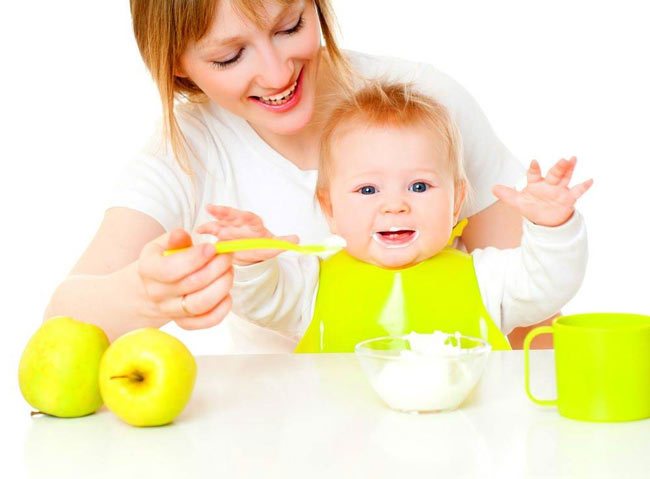
Of course, thanks to modern cooking technologies, it is possible to increase the shelf life, but still there are significantly fewer living beneficial bacteria in such a product. All other fermented milk products, which simply have exorbitant terms, do not provide any benefit, and they are even harmful for the child’s body.
Name
If the package says yoghurt product, or some other word like yoghurt, biogurt, then this product is far from yoghurt. Such products do not contain anything valuable; they have a different preparation technology and a complete absence of living bacteria.
A real fermented milk product has only one name: “Yoghurt”.
For the baby doll
Natural fruits are stored very little, which means that a priori they cannot be included in the composition. If there are additives based on natural juices, berries, fruits, then there is a preservative that helps prolong their life. Do we really want to give preservatives to toddlers?
Of course not, which means we choose yogurt without additives. As for fat content, children under 2 years old should choose no higher than 2.5%. After 2, up to 5%.
Package
A self-respecting manufacturer never hides anything from his consumer, because he values his honest name. Therefore, in addition to the name, the packaging must indicate:
- Term
- Company details
- Composition (in descending order, the first is always written as what is greater)
- Sourdough method
- Recommended age on children's products
At what age can a child be given yogurt?
According to pediatricians, yogurt can be introduced into a child's diet from 6-9 months as complementary food . If a child has no problems with the gastrointestinal tract since birth, then adult food should be given to the baby in this order: vegetables, cereals, dairy products, fruits.
If there were digestive problems, for example, the same dysbiosis, then it is better to start complementary feeding with yogurt at 6 months in order to populate the intestines with the microflora necessary for its further functioning, and then you can safely introduce vegetables, cereals and fruits.
Store-bought or homemade – which yogurt should you not buy and why?
Of course, it is better to feed your child homemade yogurt prepared with your own hands. But if you do not have this opportunity, you should carefully study children's desserts from stores. As a rule, the packages of children's yoghurts indicate at what age children are allowed to eat them.
But there are still general rules that you should pay attention to when buying store-bought yogurt.
What makes a good baby yogurt different:
- Has a short shelf life.
- It contains no flavorings, colors or fruit fillers, as well as all sorts of unfamiliar or simply suspicious ingredients (remember what real yogurt is made of). It is better not to buy such desserts rich in various additives for your child.
- Packaging – glass bottle is best.
5 best children's yoghurts in Russia according to nutritionists:
- Drinking yogurt "Rastishka".
- Bioyogurt "Tema".
- Yogurt "Agusha".
- Yogurt “Miracle”.
- Yogurt "Velle".
How to feed
At what age is it best to give?
So, your little one has grown to 7 months and is ready for the first try of fermented milk products. For breastfed babies, pediatricians and pediatric nutritionists recommend starting to introduce yoghurts and kefir from 7 to 9 months.

When to give it to her baby at 7, 8, or 9 months, the mother decides on her own, after consultation with the doctor.
Time
The best time for the first test will be in the morning. Because during the day the mother will be able to monitor the baby’s condition.
If no alarming symptoms appear after three days, then the baby doll tolerates the product normally. Next, yogurt is used as an afternoon snack in the afternoon.
By the way: Nutritionists believe that kefir, yogurt, and cottage cheese are better absorbed in the period from 4 to 6 pm.
Live yogurts that do not indicate that they are suitable for baby food should not be given to children under 2 years of age.
A portion
The first trial, like any other new complementary food, starts with half a spoon, gradually increasing the portion until it reaches:
- Child up to one year – 100 ml.
- From one year to 3 years – 200 ml.
How to make unsweetened yogurt tastier - healthy additives
Unsweetened yogurt is a healthy, versatile product for children. But kids don’t always eat it with pleasure precisely because it’s tasteless.
How can you make yogurt taste great, and what healthy additives can you use?
Dried fruits . Raisins and dried apricots are very healthy on their own. If you add them to yogurt, it will not lose its value and will acquire a sweetish note. Moreover, children always like to catch dried fruits from yogurt and its absorption turns into a kind of game.
Vanilla . It has a great aroma that many people love. If you add a little vanilla to the finished yogurt, it will be incredibly aromatic and appetizing. The main thing is not to overdo it, otherwise the product will be slightly bitter.
Nuts . Nuts are rich in fats, which are so necessary for a growing child's body. They help make yogurt not only tastier, but also more satisfying. Cashews, almonds, hazelnuts and walnuts make great healthy additions.
Muesli . They can also change the taste of yogurt and make it more filling. The flakes become soft and melting, which many children like.
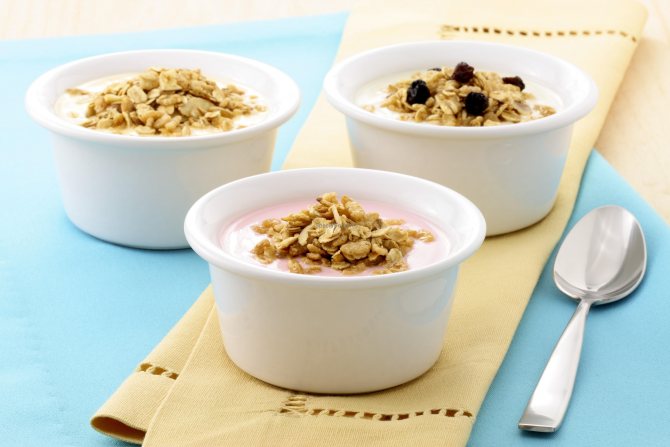
You can also use other products as additives that can make yogurt tastier. The main thing is to monitor the reaction of the child’s body and the baby himself, so that experiments with taste do not turn into treatment for allergies.
How to prepare delicious and healthy yogurt for your child at home?
The process of making yogurt does not take much time and does not require much effort.
To create a high-quality product, we need milk, a starter (a complex of beneficial bacteria), which today can be bought in any supermarket in the dairy products department, as well as a yogurt maker or thermos .
On a note!
To prepare baby yogurt, it is best to use skim milk so that there is no heavy strain on the pancreas.
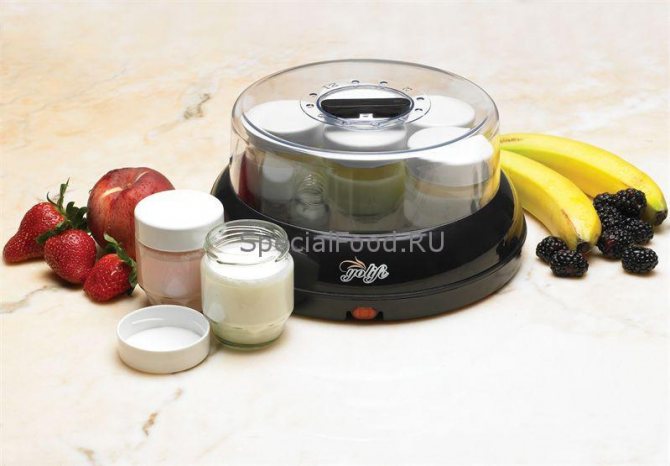
To begin with, the milk should be boiled and cooled to 40-45 degrees. Next, you need to prepare sterilized dishes - these can be ordinary jars or cups from a yogurt maker. Then we proceed to dilute the starter. It is worth clarifying that you can use any store-bought baby yogurt instead, at a rate of 2-3 tablespoons per 1 liter of milk. A special starter needs to be diluted with boiling water.
Basically, the principle of preparing sourdough is the same for all manufacturers: pour boiling water into the container about 2/3 full, carefully place it and pour the finished mixture into the already cooled milk. Pour the milk into a bowl and leave it to cook for 6-8 hours in a constantly warm environment. During this time, the required number of beneficial bacteria has time to multiply.
On a note! You can give yogurt to your child with various additives - syrups, fruits, chocolate. But remember: if you add sugar to it, you need to do this only with ready-made yogurt, otherwise the sugar will begin to react with the bacteria of the starter, and the end result will not be the product you expect.
How to prepare “Yogurt for children”
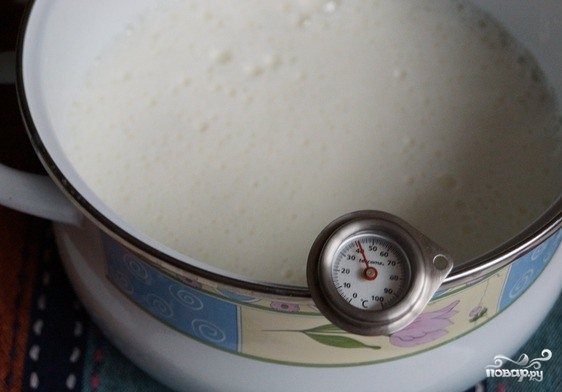
Pour two liters of milk into a saucepan, place it on the stove and bring to a boil over low heat so that it does not burn or run away. Add a tablespoon of sugar to the milk. It is better to take homemade, winnowed milk. Cool it to forty degrees.
Open the jar of starter and stir its contents into the milk. You can buy any starter at the pharmacy; there are many varieties. The milk should not be hot, otherwise all the beneficial bacteria will die.
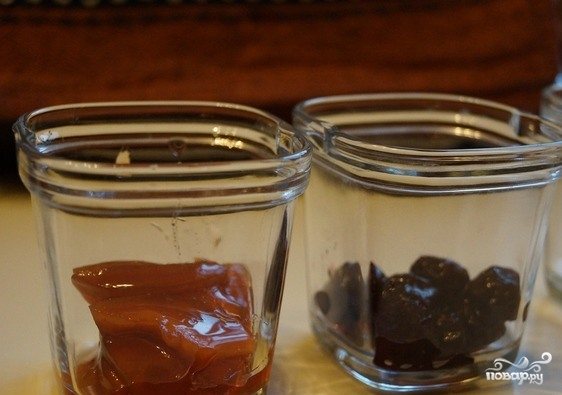
Put a little jam (any jam to your taste) into the yogurt jars. You cannot add fresh berries, as their acidity will cause the milk to curdle during the preparation of yogurt.
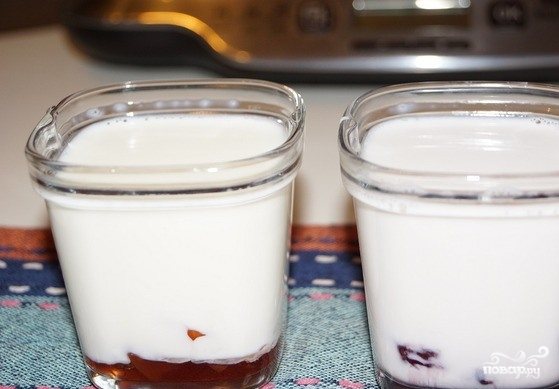
Pour the milk with the starter into jars of jam. If you don't like sweet yoghurts or your child is allergic to jam, you can do without it by adding more sugar to the milk for sweetness.
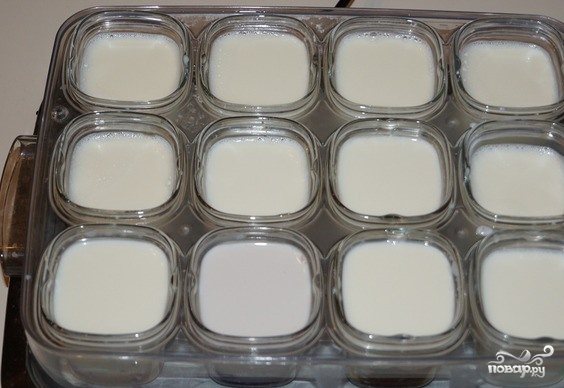
Place the jars of milk in the yogurt maker for ten hours. If you do not have such a device, you can leave the yogurt in the oven at a minimum temperature. Some people prefer to do this in a slow cooker, thermos, or simply near a radiator, wrapping the yogurt in a blanket. Place the finished product in the refrigerator for a couple of hours, decorate with jam on top.
